Executive Summary
Gard Hollinger of L.A. County Choprods made a name for himself as a premier custom bike builder. His work has been seen on TV shows (Discovery Channel's Biker Build-Off) and he's built customized bikes for some of Hollywood's elite. Hollinger opens the doors of his shop to show how the versatility of his welding fleet and variety of projects - from high-end customizations to production-level parts - makes L.A.County Choprods a leader in motorsports fabrication.
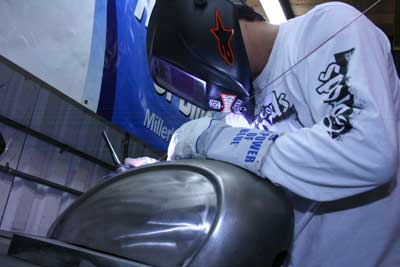 |
| Gard Hollinger welds a gas tank for a custom motorcycle in his Gardena, California headquarters. |
Gard Hollinger has done it all, from racer and showman to architect and mastermind. Amid the flash and sizzle, however, resides an artist whose real passion is using steel as paint and the classic Harley motorcycle as his canvas.
"I was immediately drawn to using this iconic brand as a foundation for something artistic," says Hollinger. "I started building my own stuff, and I tried to blend in the motorcycle background that I had from the competition-side with my own style and sense of motorcycle history. It grew from there, and for the last 15 years that is all I've done."
If steel is his paint and a Harley is his canvas, then surely the man needs a brush. But as any artist knows, each brush has different capabilities and specialties. For that reason, Hollinger and his cohorts at L.A. County Choprods rely on three inverter-based welding machines to build each bike: A Millermatic® all-in-one welder with conventional MIG and pulsed MIG outputs, a Dynasty® AC/DC TIG welder with advanced arc control and a Maxstar® 200 DC TIG inverter.
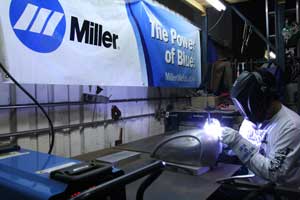 |
|
Hollinger relies on a Dynasty TIG inverter for welding aluminum.
Advanced squarewave controls and the ability to adjust balance
and frequency allow him to fine tune the arc to meet his specifications.
|
Building L.A. County Choprods
Nothing about L.A. County Choprods is contrived. Hollinger runs a lean operation. He has run larger businesses-including a motorcycle dealership that employed as many as 12 people-but his creative passion and attention to detail has landed him at his current shop in Gardena, California. Here, he and three coworkers focus on quality, attention to detail and the artistic side of a business that's much more than just aluminum, steel and gasoline.
"There are artists in this industry that you can instantly tell their work," he says. "It has a soul. And you can tell the difference between one of their bikes and a bike that someone has tried to copy. I try to be a minimalist with the bikes that I build while having them reflect something from my competitive background, and blend that with an era. That may be from the 20s or 30s, where it's got a board-track look, or it might be more of that classic biker look from the 70s or 80s. And I always blend it with technical performance qualities."
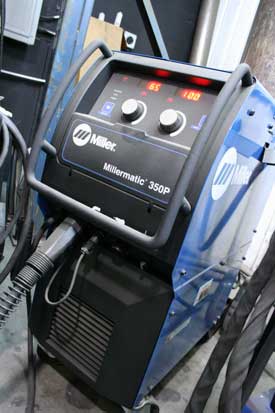 |
The Millermatic 350P gives L.A. County Choprods a
Pulsed MIG solution for welding thin sheet metal. |
In the spirit of technical performance (and increasing demand from an influx of DIY bike builders), L.A. County Choprods also manufactures a line of high-performance parts, including gas and oil tanks, brakes, brackets and throttle components. The L.A. County shop includes a lathe, a Bridgeport mill, sheet metal brakes, pan brakes, press brakes and band saws. Hollinger farms out any CNC or programmable machining parts, but fixtures and assembles the final product in his shop. His collection of MIG and TIG welding equipment each serves a purpose in his day-to-day operations.
Pulsed MIG Improves Speed and Quality on Sheet Metal
Hollinger never had the need for an advanced Pulsed MIG welder until he began manufacturing oil and gas tanks out of 14- and 18-ga. sheet metal for another bike builder. Hollinger also supplied exhaust systems and c-pans, including some components up to 1/8-in. thick. To increase the speed of production without sacrificing quality, Hollinger turned to Pulsed MIG.
"We were dealing with a lot of light gauge steel and butt joints," he explains. "It was hard to use a standard MIG and control it without burning through the metal and have a bunch of ugly slag or poor sections in the vessel being welded. All of these parts are pressure tested. Using a welder with pulsing capabilities was the only way we were able to make it work."
Hollinger achieved the Pulsed MIG welds he was looking for with the Millermatic 350P. Pulsed MIG puts less heat into the work yet maintains good fusion, fast travel speeds and excellent bead appearance. While Hollinger was not an expert at Pulsed MIG, he quickly familiarized himself with the machine and achieved the results he was looking for.
"It became just like a fast TIG weld," he says. "It allows the metal to cool between the pulse so that we don't burn through, which not only improves the quality and strength but prevents us from having to spend time fixing it."
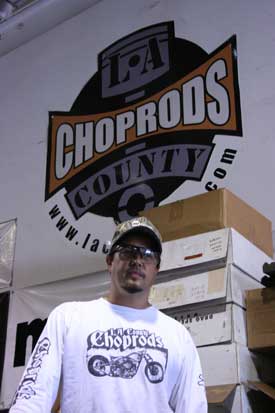 |
| Gard Hollinger, L.A. County Choprods. |
TIG Inverters Provide One-Two Punch of Productivity, Portability
Hollinger's bread-and-butter is his TIG welding. A 300-amp Dynasty AC/DC welder handles L.A. County's larger steel and aluminum assemblies, while the Maxstar 200, which is smaller and more portable, handles anything too cumbersome to bring back to the welding station.
"The Dynasty gives me a heavy enough duty cycle where I can do heavy production TIG welding and not worry about it keeping up," he says. "I really like the adjustable frequency when AC TIG welding. It's a cleaner, easier weld. The ability to change the frequency and balance controls really helps in adjusting for cleanliness, penetration, heat affected zone and different thicknesses of material."
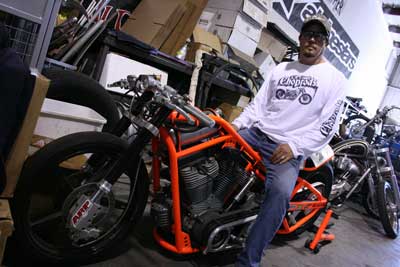 |
| Gard Hollinger and the Biker Build-Off Bike, a.k.a., "Super A.D.D." |
Just like a variety of paint brush sizes gives an artist more flexibility, Dynasty welders offer advanced controls that allow Hollinger to customize the arc to the application. This includes tools to adjust bead width, penetration, "cleaning action" (the white etched zone on the sides of any aluminum weld), total heat input and travel speed.
"We'll be working on 20- to 22-gauge sheet metal and then switch to a ½-in. thick piece of steel," says Hollinger. Then, he can "push a button and start welding an aluminum gas tank. That's really the go-to machine, and we haven't found anything that it won't do."
Hollinger keeps the Maxstar 200 for its ability to weld steel and stainless up to ¼-in. thick and for its portability. This 200-amp welder packs more than enough power to handle the extensive tacking and mocking that goes into assembling a bike, yet weighs just 37 lbs. and runs on any type of primary power in the world, from 190V to 460V.
"It's a really nice, portable machine," says Hollinger. "We can plug in to any power throughout the shop and go to work. It's a lot easier than dragging every project to the weld station or pulling the Dynasty across the shop for tacking."
SIDEBAR: L.A. County Choprods' Gard Hollinger Impresses on Biker Build-Off
Hollinger was given a shot to showcase his skills and style as part of the show Biker Build-Off on The Discovery Channel. The bike, named Super A.D.D., lost the competition on technicalities but won fans with its style and performance.
While Hollinger had spent years racing off-road motorcycles and building countless other bikes, he had never sat at the controls of a drag bike. When the producers of Biker Build-Off approached him to do the show, he agreed on one condition: that he and the other builder would not only build their bikes, but they would also compete in a drag race.
"I had never drag raced in my life," says Hollinger, "and the other guy had done it a little bit. So we built these drag bikes and I ended up building a 9-second quarter-mile bike that was streetable. I had no idea what that meant."
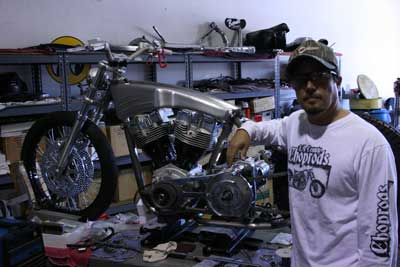 |
Gard Hollinger shows off a new project built almost entirely of aluminum-from
the chassis to the gas and oil tanks. |
What it meant was impressive, considering the top class bikes and drivers complete the quarter-mile somewhere between 6 and 7 seconds. Hollinger beat his competition by two seconds on the first run. The second run was a bit more painful: Hollinger dislocated his shoulder while launching off the line and he lost that heat. He announced that he was ready to go after a quick inspection of his shoulder in the ambulance and he lined up for the third heat, which he subsequently defaulted on: his bike red-lit the rear beam. Hollinger waited and watched the other driver speed away. Not to be outdone, he decided to run the heat anyway and actually beat the other bike to the finish line. He lost on default, but he had the faster bike.
"It was very dramatic," says Hollinger, with a smile. "It made for a great episode."
He shared this regarding the bike's design:
"We tried to build a unique shape to the chassis," recalls Hollinger. "It's mostly mild steel DOM [round tubing] with a bit of a rectangular structure. There are many welded joints and we were very rigid with the frame so that it was not only safe, but so that it transferred the power to the ground. It's very unconventional for a drag bike, but the dimensions were fed to me by (component builder) Sandy Kosman, and that's how we determined where we wanted to have the engine in relationship to the front axle, the overall wheel base of it, and those things helped with the handling characteristics. It performed incredibly."
Hollinger looks back at the Biker Build-Off experience fondly.
"It was a lot of fun-it was something I quickly realized I needed to back away from when it was done because I don't need any more time-consuming, expensive hobbies. It was a lot of fun."